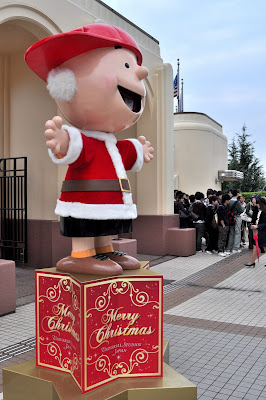 |
| Welcome to USJ - where Christmas arrives with November! |
This past weekend, I finally indulged in the requisite visit to
Universal Studios Japan that seems to find its way on to most Kansai Gaidai international students’ itineraries at some point in their stay here in Hirakata. Theme parks on weekends are full of people – in between all the rides and shows and intoxicating smells, a barrage of visual (and aural, and olfactory, and so on…) anthropology assaults the senses.
 |
| Mine-chan and I take a classic Japanese photo-op in yet another queue! |
Long lines for attractions also mean time to talk with Japanese students; I went with Haru, who I featured
a few blog posts back, and her high school friend Mine-chan. While waiting an advertised 45 minutes for the Hollywood Dream ジェットコースター (‘jet coaster’ – the Japanese use this general term for rides), Haru asked me whether lines were this long in America. Not being a frequenter of Disneyland and other theme parks in the U.S., I wasn’t really sure, but Haru had earlier informed me that we could potentially have to wait 2 and a half hours for some attractions, which can be
standard at Tokyo Disney as well. I felt pretty certain that Americans would be too impatient to queue for that amount of time; Haru and I together speculated about Japanese and American willingness to wait in lines. Undoubtedly, in depends on the sub-culture, and what they may be waiting for (teens sleeping outside the Nederlander theatre to get rush tickets to RENT on Broadway?) – but lining up seems to be more acceptable, even popular, among the Japanese.
A few weeks ago in Shinsaibashi, I was momentarily bewildered by a queue outside of Krispy Kreme that extended through the crosswalk and into the neighboring shopping street – this is a sight unseen in America. But this model is not limited to one shop in Osaka – Krispy Kreme (and other, notably, Western imports like Coldstone Creamery) in Tokyo and beyond experience similar queues. Check out some interesting analysis of the phenomenon
here. To the Japanese, long lines equate with a quality product – be it a delicious doughnut or, with a jet coaster, the chance to regurgitate said doughnut. But more than simply rewarded patience, waiting on lines seems to reflect some cultural aspects of Japan, like gaman – the concept of enduring without complaint in order to succeed.
Later in the day at USJ, queuing up for the new attraction Space Fantasy, I noticed that there is, in fact, a single rider line – but no one seemed to be using it. I asked Haru if she thought this might be because Japanese tend to do things in groups, and she agreed, Although even Americans would likely not go to a theme park alone, this does seem to be a nice example of Japanese 集団主義 (
'shuudanshugi') – group collectivism – and particularly its relation to waiting in lines – the idea that if a group of Japanese have given their approval to a ride or donut by their physical presence in line for it, another Japanese, being of the same cultural in-group, should naturally line up too – even without necessarily knowing what they are lining up for:
“In an article published in The Japan Times in summer 2007, a Japanese woman confessed that she enjoyed queuing outside shops and restaurants and that she usually joins the line before asking the person in front of her what kind of product is sold.” (Kohlbacher & Holtschneider)
In our discussion of 集団主義, though, Haru stressed that she personally feels at times constrained by the group mentality; consequently, she tries to take time to do certain things alone, like the occasional solo shopping trip.
The weekend of queue-based speculation is over, but earlier today, in sharing about my weekend visit to USJ, I ended up talking to another Japanese friend about Disneyland. At one point, she asked if there is a Disneyland in America – the extent to which Western theme parks, doughnuts, and sundry other bits of society have been appropriated into Japanese culture is just as intriguing as the patience with which they will wait to enjoy these borrowed pleasures…
 |
| Charlie Brown Christmas meets Universal Studios meets queuing Japanese students... |